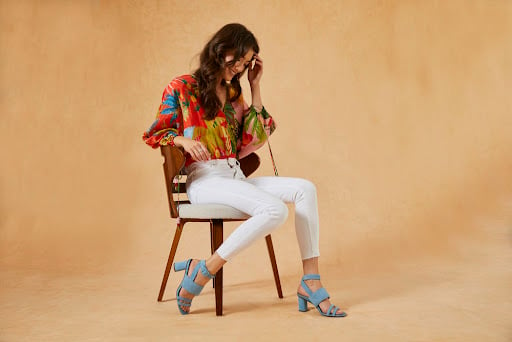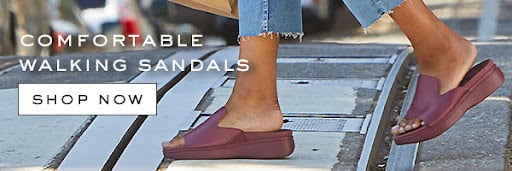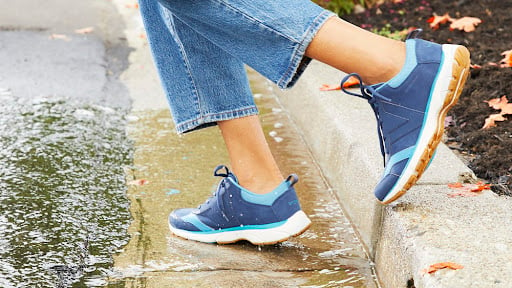Trying to find the best shoes for your feet can make you feel a bit like Goldilocks. Sometimes your shoes are too small, sometimes too big, and finding shoes that are just right might sound like a fairy tale. If you have narrow feet, finding a balance of comfort and support means you’ll need some carefully-chosen footwear.
If you’ve struggled with finding footwear due to a narrow build, you’re certainly not alone—but it’s important not to ignore the problem. The American Podiatric Medicine Association estimates that about two-thirds of Americans wear shoes that hurt their feet.1
So, how can you find shoes designed for you? Step through this guide to identify the shoes you should look for and identify footwear solutions that prioritize a healthy you.
Footwear Qualities to Consider
Ideally, people with narrow feet should wear a narrow shoe. However, finding shoes in narrow sizes is a task in itself. It’s common sense that your feet will feel better when your shoes fit well and provide protection. Of course, you also want to match the fit of your footwear to its function—you may not want to wear your steel-toed boots to your next brunch, but you’ll need the former in other situations.
However, when it comes to finding protection for narrow feet, running a marathon and a day at the office can require some similar considerations.
Here’s a checklist of features to identify when searching for shoes for narrow feet:
- Measure at the balls of your feet – When checking whether a shoe is the right width for your narrow feet, measure at the widest point. If there’s too much room (or not enough) at the balls of your feet, you may need a different size.
- Give your toes some wiggle room – If you have narrow feet, it can be tempting to choose a smaller shoe size to find the right foot width. But for the sake of comfort, it’s important not to choose shoes that are too short. Podiatrists advise that there should be about 3/8 to 1/2 an inch of space, about a finger’s width, between your longest toe and the end of your shoe. This allows toes enough space to move without excessive sliding.
- Look for removable insoles – It’s always beneficial to have the option to change out the insole of a shoe and the padding for more accommodating materials. If you have narrow feet, you may want to add shoe inserts with slightly more support or a thicker insole to achieve a more snug fit.
- Find shoes that can adjust to you – Shoes with adjustable straps, shoestrings, and supports can help you achieve a better fit. For example, a pair of slide sandals may be too wide but could fit your narrow feet perfectly if the adjustable strap can be tightened.
- Seek flexible materials – Flexible materials like leather or synthetics are more likely to mold to your foot over time and offer unique support. They can also help minimize pain in heel and other sore feet causes.
The Best Footwear Designs For Narrow Feet
Aside from finding shoes with narrow fit options built-in, adjustable and form-fitting options are key when considering shoes for narrow feet. Tightening laces and straps can help prevent slipping and promote support. Consider these narrow=feet-friendly favorites:
#1 Supportive Sandals
Prioritize material that’s able to mold to your foot shape with wear. Sandal straps can keep your heel in place, while the open-air quality prevents chafing during all your warm-weather exploring.
The Rejuvenate Recovery Sandal features a molded footbed that hugs your foot while grips keep your heel from slipping. The adjustable strap can help narrow feet stay snug and supported.
#2 Boots
If straps and laces just aren’t your thing, boots can supplement support. Styles that sit higher on the leg can provide more ankle support in particular—a key component to help narrow feet sliding around in your shoes.
The Gwen Tall Boot features a secure fit with various width options. Plus, the soles are lined with rubber for all your year round-weather requirements.
#3 Sneakers
Sneakers are the number one recommendation from podiatrists for all-around support.1 The best running shoes for narrow feet must have flexible, supportive materials and adjustable laces. You can read more about how to choose the best running shoes for your feet.
Sporty style meets everyday with options like the Zanny shoe. The design comes in three neutral colors and a timeless adjustable fit to help you sprint for the train or conquer hours at your standing desk.
#4 Platforms
Even if you have narrow feet, you still need extra space so your foot isn’t constricted. An alternative to the heel for some added height, platform shoes allow the foot to relax by adding extra shock absorption. Plus, some platform options feature ties and comfortable laces to keep the foot snug and perched. They could be one of the best walking shoes for people with narrow feet.
The Monica Platform Sandals feature a trendy 1.25-inch platform and will form to your feet for an adjustable fit. In colder weather, consider a closed-toe platform like the Nolan Boot. This waterproof leather platform shoe comes in a sleek style, perfect for a dog walk or a downtown dinner.
Other Tips and Tricks to Accommodate Narrow Feet
If you’ve realized your shoes may not be suitable for your narrow size—or you need some tips to help your narrow feet fit better in that pair of shoes you simply love—you can also opt for damage control rather than the discard pile.
Here are some ways to help your narrow feet fit more comfortably when your shoes have a little too much wiggle room:
- Padded Socks – Adding an extra layer between your foot and your shoe can help prevent rubbing-related irritation. This option is particular to shoes that may be too loose, as adding thickness to an already tight shoe will do more harm than good.
- Orthotic insoles – Orthotic insoles can provide a little extra support and grip inside your shoe, helping to prevent your foot from swimming in space. A slim fit insole can also help to align the foot in its natural position. If you struggle with foot issues like plantar fasciitis, choosing hard or soft orthotics for plantar fasciitis can provide great relief.
- Laces – Most lace-up shoes feature extra holes in the front of the shoe, specifically for those with more narrow builds. Often overlooked, adding this extra level of tightness may let you pull that pair out of the closet more often.
How to Know if Your Feet Are Narrow
Curious about whether you have narrow feet or simply need a smaller shoe size? Measure your feet at the widest width, typically across the ball of your foot, and consult your country’s width chart. Different average width lengths are set for each shoe size. If you fall below the indicated average, you may have narrow feet.3
The average shoe size for women in the U.S. is 8.5 or 9.3 This corresponds to an average of about 4 inches in width. The average shoe size for men is 10.5, which corresponds to an average of 4 1/16th inches. If you fall below these scale measurements, your feet are considered narrow.
In the U.S., most shoe widths are measured with a particular letter system. Note that children’s shoe sizes don’t typically come in varying widths, so this system only corresponds to adult shoe sizes. For narrow and medium widths, most shoe providers will indicate the following:
- AA or A – Women’s narrow
- M or B – Women’s medium
- B – Men’s narrow
- D – Men’s medium
If you’re looking for narrow width shoes, keeping an eye out for these symbols can help you identify the perfect pair.
What Causes Narrow Feet?
While some medical conditions can affect foot shape—like Cohen syndrome, which affects a body’s development, or Marfan syndrome, which affects bone structures—narrow feet are most often just genetic.2
Foot dimensions may also be gendered. An older study by the National Shoe Retailers Association indicated that roughly 30% of women have narrow feet.3
However, foot shapes are still highly individual. In fact, in 2018, the Institute of Quality and Efficiency in Healthcare established that most individuals have slightly asymmetrical feet—meaning that, often, your feet can have two different sizes or widths. If this is the case for you, the key advice is to find shoes that fit the larger of your feet. This can prevent painful rubbing and chafing for the larger foot.
What Shoes to Avoid for Narrow Feet
While narrow feet pose no health issues on their own, when paired with ill-fitting footwear, they may contribute to the following:4
- Irritation on soles due to shifting on the footbed
- Blisters and bunions from friction on heels and toes
- Twisted or sprained ankles related to lack of support
For that reason, it’s important to know what shoes to steer clear from when shopping for narrow footwear. Podiatrists across the board recommend that most individuals, and particularly those with narrow feet, stay away from the below list:
- Unsupportive flat shoes – Many ballet flats and loafers, though trendy, provide little to no arch support, which can contribute to strains. If your feet are too narrow, a lack of ankle support may also cause your feet to be overworked as they try to keep the shoe bed steady. If you do opt for flats, be sure to find those designed with extra support in mind.
- Strapless shoes – Non-adjustable slip-on options can leave little room for sizing flaws. If shoes are too roomy or too tight, your feet can suffer from excessive friction.
- Clogs – Often made of unforgiving and hard materials like wood, clogs can exert excessive pressure on the sensitive nerves in your feet. Plus, if your feet constantly slip around, you may risk overworking your foot muscles.
- Plastic shoes – This material may be trendy, but it also often provides no flexibility and is difficult to match to a foot’s form. It’s best to avoid the health risks posed by allowing your foot to slip and slide.
- Heels and wedges – Heels shift pressure to the balls of your feet, forcing your hips forward and exerting strain on your legs and back. Coupling this with an incorrect width can disrupt balance and cause significant discomfort. Instead, look for height-boosting options that don’t add pressure and strain, like the platforms mentioned above.
Take Your Shoes a Step Above with Vionic
Finding the right shoes means supporting your body’s well-being from the ground up. While it can be harder to find the right fit for narrow feet, it’s crucial not to compromise. Your footwear choices are central to your body’s overall health. From commuting and hiking to running everyday errands and exploring, putting trust in your footwear to contribute to your well-being is a must.
With Vionic, you never have to forfeit comfort for style. Vionic rejects the myth that one shoe size fits all. No two people are alike, and our footwear should tell the same story. That’s why Vionic designs shoes that target multiple support zones throughout the foot.
From boots to mules, we provide detailed sizing guides to help you consider every angle. With various widths available in each style, none of your favorite designs are off-limits. Engineered for unique feet, expect your Vionic shoes to be just the right pair to stand in as your go-to shoe.
Sources:
- American Podiatric Medicine Association. Down at Their Heels: Heel Pain Tops America’s List of Persistent Foot Ailments. https://www.apma.org/files/FileDownloads/APMAFootAilmentsSurveyNewsWorthyAnalysis012309.pdf
- National Library of Medicine. Narrow Foot. https://www.ncbi.nlm.nih.gov/medgen/108395
- Chicago Tribune. Can’t get shoes to fit? https://www.chicagotribune.com/news/ct-xpm-2001-09-12-0109130241-story.html
- Journal of Foot and Ankle Research. Incorrectly fitted footwear, foot pain, and foot disorders. https://www.ncbi.nlm.nih.gov/pmc/articles/PMC6064070/
- Footwear Retailers and Distributors of America. Americans’ feet getting bigger, but shoe choices slim. https://fdra.org/latest-news/americans-feet-getting-bigger-but-shoe-choices-slim/
- Institute of Preventive Foot Therapy. Causes of Narrow Heels. https://www.ipfh.org/foot-conditions/foot-conditions-a-z/narrow-heels/causes-of-narrow-heels
- International Size Charts Reference Guide. Shoe Sizing Guide With Standard Shoe Sizes. https://sizecharts.net/shoe-sizing-guide
- FootcareMD. How Do You Find The Right Shoes?. https://www.footcaremd.org/resources/how-to-help/10-points-of-proper-shoe-fit#:~:text=Stand%20up%20and%20make%20sure,slip%20or%20slide%20while%20walking




Leave a Reply